THE HISTORY OF UNITED Way of Marathon County
Getting Started
Mention the words “Community Chest” and most people immediately think of the board game Monopoly. But, Parker Brothers, Inc. was just reflecting a common “door to door” cause when they included a yellow card saying “Pay Community Chest $20” in one of the best-selling games ever.
 In the summer of 1930, a group of Wausau businessmen and civic leaders felt the time was right for the Wausau area to organize a Community Chest. The intent was to consolidate the many fund-raising activities to avoid duplication of effort and costs. The goal in 1930 was $60,000, but the community raised almost $75,000 – at a time when this country was reeling from the stock market crash of 1929. The first campaign theme was “Help Meet the Need” and during most of the 1930s, the campaign was conducted for one week in October.
In the summer of 1930, a group of Wausau businessmen and civic leaders felt the time was right for the Wausau area to organize a Community Chest. The intent was to consolidate the many fund-raising activities to avoid duplication of effort and costs. The goal in 1930 was $60,000, but the community raised almost $75,000 – at a time when this country was reeling from the stock market crash of 1929. The first campaign theme was “Help Meet the Need” and during most of the 1930s, the campaign was conducted for one week in October.
World War II Increases Need
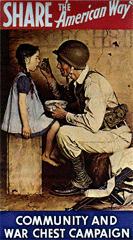 As the Community Chest moved into its second decade, the impending war in Europe is evident in the material and ads of the Community Chest. The 1940 campaign theme was “Count your blessings as Americans,” followed in 1942 by an ad copy that read “Some of us must fight and die! Some of us must work and Pay! If you can’t Go – Give.” During World War II, sixteen foreign War Relief efforts were added to the list of funded programs, including two that evolved into Lutheran Social Services and Catholic Charities. Also during this time, there were frequent references to patriotism mixed with religion as reasons to support the Community Chest. With the end of World War II, the focus of the Community Chest changed to rebuilding, children, families, and the American Dream.
As the Community Chest moved into its second decade, the impending war in Europe is evident in the material and ads of the Community Chest. The 1940 campaign theme was “Count your blessings as Americans,” followed in 1942 by an ad copy that read “Some of us must fight and die! Some of us must work and Pay! If you can’t Go – Give.” During World War II, sixteen foreign War Relief efforts were added to the list of funded programs, including two that evolved into Lutheran Social Services and Catholic Charities. Also during this time, there were frequent references to patriotism mixed with religion as reasons to support the Community Chest. With the end of World War II, the focus of the Community Chest changed to rebuilding, children, families, and the American Dream.
The United Fund
There were many changes in 1957. The Wausau Community Chest became the United Fund of Marathon County. The occasion was marked by the lighting of an Olympic torch on the Courthouse lawn to recognize our United Fund as the 1000th Fund in the United States. Dignitaries from across the state and nation attended the event or sent congratulatory telegrams.
 Stan Staples, president of the United Fund, stated at the time, “Community Chest was an organization of agencies; United Fund will be an organization of givers.” During the next decade, the United Fund campaign grew to include thousands of new donors.
Stan Staples, president of the United Fund, stated at the time, “Community Chest was an organization of agencies; United Fund will be an organization of givers.” During the next decade, the United Fund campaign grew to include thousands of new donors.
During the late 1950s and 1960s, more than 15 new partner agencies were added to the United Fund family. Most of these focused on disease prevention or providing services to those affected by terminal or long-term illnesses. The “dread diseases” of cancer, heart attack, polio, and others were a major concern, and United Fund not only contributed money but purchased equipment for local hospitals.
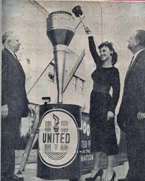 Miss Virginia Lemanski, Detroit’s “Miss Torchy” of 1956, uses the Olympic Games torch to light the big new torch which symbolizes the United Fund of Marathon County. Looking on are James Linen (right), president of the United Funds and Councils of America and publisher of Time Magazine, and S.F. Staples, first president of the new county United Fund. The ceremony took place on the courthouse lawn after Miss Lemanski and Linen arrived here by plane from Detroit, the first United Fund city, which sent “Torchy” to salute the Marathon County unit, 1,000th United Fund in America.
Miss Virginia Lemanski, Detroit’s “Miss Torchy” of 1956, uses the Olympic Games torch to light the big new torch which symbolizes the United Fund of Marathon County. Looking on are James Linen (right), president of the United Funds and Councils of America and publisher of Time Magazine, and S.F. Staples, first president of the new county United Fund. The ceremony took place on the courthouse lawn after Miss Lemanski and Linen arrived here by plane from Detroit, the first United Fund city, which sent “Torchy” to salute the Marathon County unit, 1,000th United Fund in America.
(…Record-Herald Photo, September 1957)
From United Fund to United Way
In 1972 the organization’s name was officially changed to United Way of Marathon County, Inc. and the role of United Way in the community began to evolve as well. The first community-wide assessment was done in 1977 — a forerunner of the biennial LIFE Report done today, and United Way provided more information about how funds were addressing real needs.
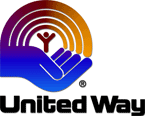 As the community changed over the years and workplace campaigns replaced door-to-door or neighbor-to-neighbor solicitation, many creative kick-off events were tried. One of the earliest was the torch-lighting ceremony, which was repeated for several years. On September 20, 1972, the campaign was kicked off with the ringing of church bells throughout the city and a United Way Sunday was held in October. The idea of Pacesetter companies starting their campaigns early and “setting the pace for the rest” was initiated in 1978 by Campaign Chair Dwight Davis.
As the community changed over the years and workplace campaigns replaced door-to-door or neighbor-to-neighbor solicitation, many creative kick-off events were tried. One of the earliest was the torch-lighting ceremony, which was repeated for several years. On September 20, 1972, the campaign was kicked off with the ringing of church bells throughout the city and a United Way Sunday was held in October. The idea of Pacesetter companies starting their campaigns early and “setting the pace for the rest” was initiated in 1978 by Campaign Chair Dwight Davis.
In 1987, with the organization of the Summit League leadership giving program, the annual campaign saw significant growth. During that same time frame, United Way increased accountability by requiring funded agencies to define how their services helped people and the number benefiting from United Way funds.
Maybe the most visible and certainly the longest-running kickoff event was the annual United Way Parade. Started in 1986 by an enthusiastic group of volunteers, the United Way parade was held on the third Saturday of September every year until 2012. Local businesses, partner agencies, and area bands participated in one of the largest parades held each year in the city of Wausau.
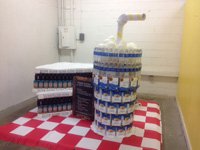 In 2013, United Way’s CommUnity Fest, a competitive food sculpture/food drive and family activity day replaced the parade. In its first three years, CommUnity Fest has resulted in more than 80,000 pounds of donated food and $10,000 in cash donations for the Marathon County Hunger Coalition.
In 2013, United Way’s CommUnity Fest, a competitive food sculpture/food drive and family activity day replaced the parade. In its first three years, CommUnity Fest has resulted in more than 80,000 pounds of donated food and $10,000 in cash donations for the Marathon County Hunger Coalition.
2009 and Beyond
The history of United Way has evolved from a fundraising organization to an organization that brings all segments of the community together to look for solutions to community-wide issues. It’s not just about how much money United Way raises, or how many people are helped. That’s important – but even more important is a focused effort to address the root causes of problems like homelessness, poverty, early childhood development, abuse, and more.
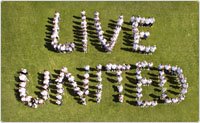 Together with community partners, United Way concentrates on preventing problems while maintaining a safety net for those in need. Since 2009, that work has been guided by the “Roadmap for Change” developed by more than 100 community members who contributed hundreds of hours and many months to meetings and discussions.
Together with community partners, United Way concentrates on preventing problems while maintaining a safety net for those in need. Since 2009, that work has been guided by the “Roadmap for Change” developed by more than 100 community members who contributed hundreds of hours and many months to meetings and discussions.
In 2014, the direction first outlined in the Roadmap for Change was reaffirmed through an extensive Strategic Planning process. During that process, five key roles for United Way were identified as part of the Strategic Plan.
- Convening – bringing community groups together to work on common goals
- Mobilizing – supporting coalitions and building capacity with volunteers and special projects
- Connecting – people to resources and volunteer opportunities
- Evaluating – determining community needs and progress
- Investing – in programs at area non-profits that get results
United Way’s work has expanded to include four Coalitions that work collaboratively with traditional funded partners to get results on important issues in our community.
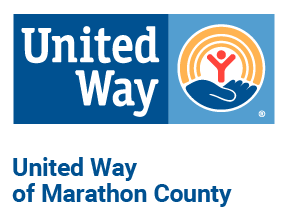
Website by: OneEach Technologies
Sitemap | Login